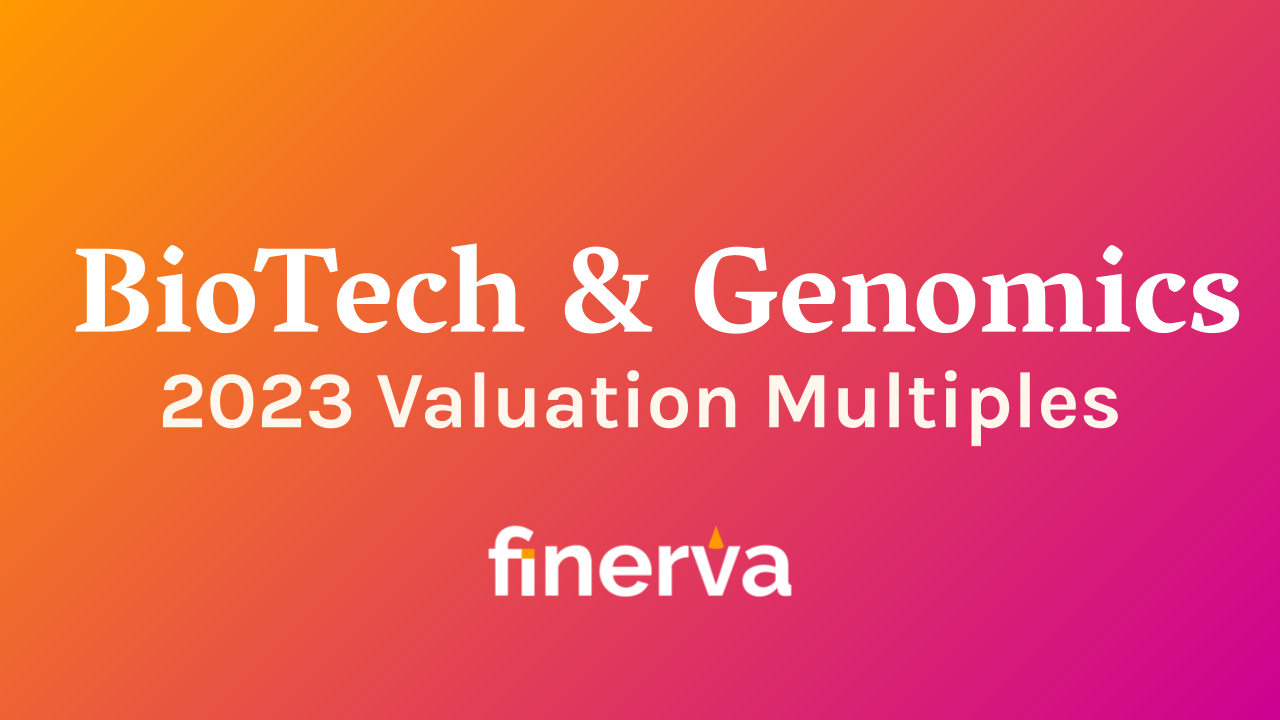BioTech & Genomics: 2023 Valuation Multiples

Advancement in BioTechnology have been fundamental in key breakthroughs in modern medicine, allowing us to treat and cure conditions that were considered irreversible until just a few years ago. BioTech—and genomics in particular—have played a key role in the worldwide response to the COVID-19 pandemic, and regularly lead to new discoveries in diagnostics and therapeutics for cancer and other life-threatening conditions.
BioTech companies operate in a highly regulated market with a few huge players and intense M&A activity both in public and private markets. There are a few other characteristics that make this sector unique in terms of risk profile, profitability and valuation:
- Firstly, BioTech and pharmaceutical companies go through a much longer path to revenue and profitability during which they incur huge costs for R&D throughout the discovery process for new drugs and treatments. It has been estimated that developing a successful drug costs $2.5bn on average.
- While for most industries business success can be measured on a spectrum that resembles a gaussian curve, new medical treatments can either be effective or not. Therefore, the risk profile tends to be binary and its assessment can change radically during the trialling process.
- Revenue streams for BioTech companies vary based on the type of condition that they aim to treat or cure. Some drugs must be administered regularly throughout the patient’s whole lifetime, while treatments—especially those involving gene therapy—that aim to permanently cure a patient have a different revenue model.
- Finally, the cost of providing cutting-edge cures and therapy is often extremely high because it requires advanced machinery, materials and chemical compounds that are scarce or hard to manufacture.
For the reasons above, calculating valuations for BioTech and Genomics companies usually relies on slightly different techniques than most sectors. Risk-Adjusted NPV and Comparable Companies Analysis are the prominent techniques as they avoid relying on financial metrics such as revenue and profits, which aren’t always available even for larger companies.
In fact, about 80% of the Nasdaq Biotech Index components are loss-making, which is very atypical for publicly listed companies. BioTech companies are regularly acquired at multi-billion valuations even before they make their first revenues.
With these caveats in mind, we wanted to provide a statistical analysis of revenue multiples for public BioTech and Genomics companies as a means of comparison, given that multiples alone are not sufficient to substantiate a valuation and the appropriate risk assessment and due diligence of the individual company’s pipeline is still necessary.
The Global X Genomics & Biotechnology ETF (GNOM), managed by Mirae Asset Financial Group, “in companies that potentially stand to benefit from further advances in the field of genomic science, such as companies involved in gene editing, genomic sequencing, genetic medicine/therapy, computational genomics, and biotechnology.”
The 41 companies in the fund are all listed on public stock exchanges, and so their financial metrics may differ from younger start-ups introducing innovative technologies, typically considered a high-risk-high-reward investment. Around 80% of these companies recorded revenue throughout the past 2 years, and less than 25% made a profit.
Genomics & BioTech Valuation Multiples
Revenue multiples for BioTech & Genomics companies grew throughout all of 2020, peaking at 17.5x in Q4 2021. After a continued fall throughout all of 2021, revenue multiples stabilised between the 6.5x and 7x mark for most of last year. In Q4 2022 the median EV/Revenue Multiple for BioTech & Genomics companies was 7.1x, lower than pre-pandemic levels, but on an ever-so-slight upwards trend from the start of 2022.
Source: YCharts
The distribution of revenue multiples is heavily skewed to the right, with the vast majority of companies staying below the 20x mark for the past 2 years except from the peak at the end of 2020, when the sector rose to prominence likely thanks to COVID-19 vaccine breakthroughs.
The top 25% of companies by revenue multiples, which constitutes the ‘long tail’ of the sample, reached higher and higher peaks throughout 2022, in some cases even passing the 100x mark.
Source: YCharts In the chart above, the lines indicate the range of EV/Revenue multiples in our cohorts, while the boxes highlight the Interquartile Range (IQR), which is where the median 50% of the cohort ranks based on their valuation multiple.
The information available on this page is of a general nature and is not intended to provide specific advice to any individuals or entities. We work hard to ensure this information is accurate at the time of publishing, although there is no guarantee that such information is accurate at the time you read this. We recommend individuals and companies seek professional advice on their circumstances and matters.




